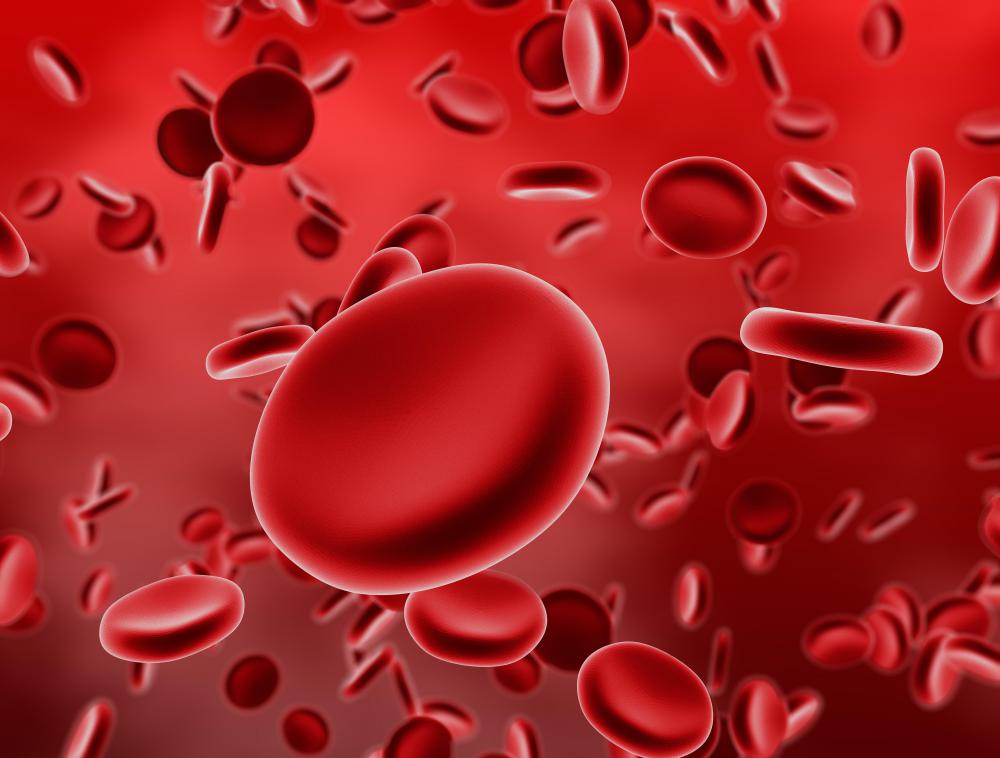At WiseGEEK, we're committed to delivering accurate, trustworthy information. Our expert-authored content is rigorously fact-checked and sourced from credible authorities. Discover how we uphold the highest standards in providing you with reliable knowledge.
What is Oxygen Saturation?
Oxygen saturation is the measurement of how much oxygen is available in the bloodstream. As blood is pumped from the heart into the body, it first goes through the lungs where oxygen molecules bind to red blood cells in order to be carried throughout the rest of the body. The percentage of red blood cells that are fully saturated with oxygen is referred to as arterial oxygen saturation or blood oxygen level. Healthy blood oxygen saturation is between 95 and 100 percent, but patients with lung disease often have a lower percentage unless they use supplementary oxygen.
A pulse oximeter is commonly used to determine oxygen saturation. This is a small device that clips onto the patient's fingertip or ear lobe and shines two beams of light, one red and one infrared, through the skin of the patient. The light beams enable the pulse oximeter to read small changes in the color of the patient's blood caused by the pulse, which in turn provides an immediate estimate of blood oxygen saturation. Pulse oximeters are most accurate when a strong pulse is present.

For a more precise reading of arterial oxygen saturation, an arterial blood gas (ABG) test may be administered. In this test, blood is typically drawn from the radial artery in the wrist, although other arteries may be used as well. This test can be a bit more painful than other blood tests — which draw from a vein rather than from an artery — but the test is quick and usually well-tolerated with minimal risk to the patient. Results from an ABG are available in minutes.

Patients with blood oxygen levels below 90 percent are considered to have hypoxemia, and a blood oxygen level below 80 percent is known as severe hypoxemia. Shortness of breath is the primary symptom of hypoxemia. There are various causes for this condition, including congenital heart disease, low cardiac output, and interstitial lung disease.
Other lung diseases that could cause hypoxemia include pulmonary fibrosis, emphysema, chronic obstructive pulmonary disease (COPD), acute respiratory distress syndrome (ARDS), anemia, airway obstruction, collapsed lung, fluid buildup in the lungs, and sleep apnea. Patients with hypoxemia may be administered oxygen to raise blood oxygen saturation and usually are advised to not smoke, to avoid air pollutants such as secondhand smoke, and to get regular exercise if at all possible. Chronic lung or heart disease will need to be treated under the advice of a specialist in order to maintain optimal health.
AS FEATURED ON:
AS FEATURED ON:















Discussion Comments
This fills me with faith in my GP! I went in with a suspected chest infection, have been coughing up mucus and coughing until my lips are blue! I have asthma. I was told by gp it's a "respiratory tract infection" and was given no treatment or help and my SATS test showed 84!
I thought it was my pulse at first, until after coughing my lungs up on the bus to my mom's (health care support worker) she told me what this was. I can't believe my gp did nothing!
It works with infrared lasers. It calculates the concentration of oxygen in your bloodstream. Between 95 and 99 percent is healthy.
@EdRick - I used to have blood pressure in that range. Turns out my decongestant was the culprit! When I switched to a nasal steroid, things looked better.
I think sometimes they do treat patients with oxygen saturation levels between 90 and 95. When I had my c-section a while back, I had trouble with my O2 sats in the recovery room. I'm not sure if it was because of the surgery or just because I was so exhausted! Anyway, when it got under 95 (I think it was 92-ish) they first tried just telling me to breathe more deeply.
But I think I kept forgetting! Anyway, it didn't go up as much as they wanted so they put me on oxygen, that nose tube thing you see. Incidentally, that thing dried my nose out something awful, and being in the hospital, it took several hours before I could get a *prescription* for saline for it!
I always wondered how those finger oximeter devices worked! I'm a pretty healthy guy but I remember being hooked up to one years ago when I had my wisdom teeth out under general anesthesia. I didn't understand how it could measure something about my blood without having direct access to my blood.
So if under 90 is bad and over 95 is good, what's the in-between range? Is it kind of like having blood pressure in the 130s--not something that needs treating, but something that needs to have a close eye kept on it?
Post your comments